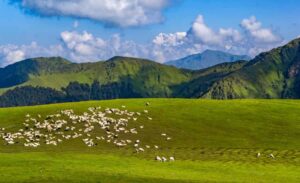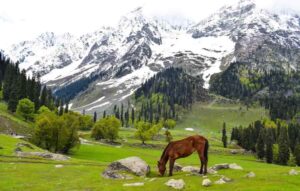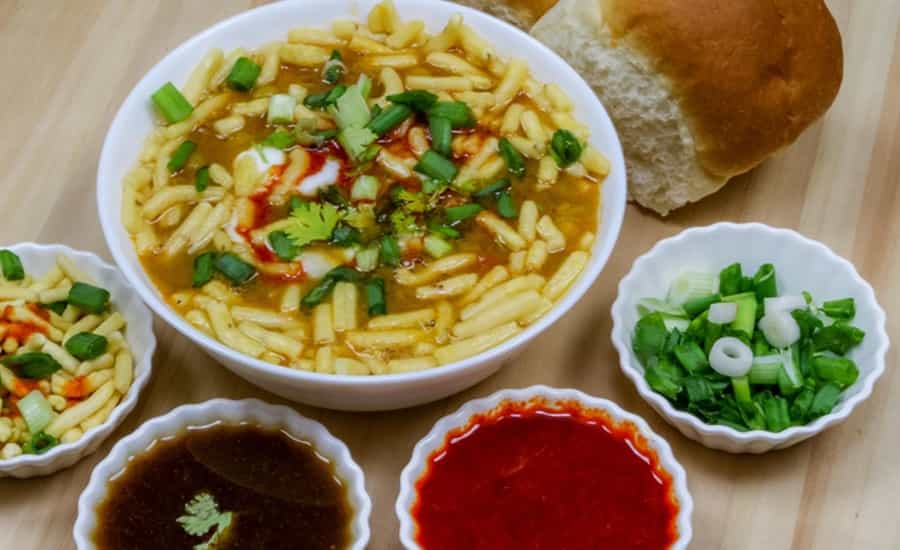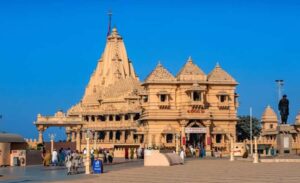Navratri Festival: A Profound Celebration of Divine Femininity
Navratri, which translates to “Nine Nights” in Sanskrit, is a significant Hindu festival that spans nine nights and ten days. It is celebrated with immense devotion and cultural richness across India and among Hindu communities around the world. This comprehensive exploration of Navratri will delve even deeper into its history, importance, the goddess it venerates, and fascinating facts associated with this spiritually and culturally rich festival.

History of Navratri
The history of Navratri can be traced back to ancient Hindu texts and mythological narratives. One of its primary historical significances lies in its association with the battle between Goddess Durga and the buffalo demon Mahishasura.
In Hindu mythology, Mahishasura was a formidable demon who could not be defeated by any god. In response to this grave threat to the cosmos, the trinity of Hindu deities—Brahma, Vishnu, and Shiva—combined their energies and created the divine goddess, Durga. She was endowed with extraordinary powers and armed with weapons provided by various gods. Riding a fierce lion, Durga waged a relentless battle against Mahishasura for nine consecutive nights and days. On the tenth day, she emerged victorious, vanquishing the demon and symbolizing the ultimate triumph of good over evil, righteousness over wickedness.
Navratri’s historical and mythological roots are also found in the ancient Indian epic, the Ramayana. Lord Rama, along with his army, worshipped Goddess Durga for nine days before embarking on his battle against Ravana, the ten-headed demon king of Lanka. Rama’s unwavering devotion to the goddess and his subsequent victory over Ravana on the tenth day signify the festival’s deep connection to this epic narrative.
Over time, Navratri has evolved and absorbed regional and cultural traditions, giving rise to a rich tapestry of diverse celebrations throughout India. Each region showcases its unique customs, making Navratri an embodiment of India’s cultural unity in diversity.
When Celebrated
Navratri, the festival of “Nine Nights,” is celebrated at different times each year as it follows the lunar calendar. It typically falls in the Hindu calendar month of Ashwin, which corresponds to September or October in the Gregorian calendar. The exact dates of Navratri vary from year to year based on the lunar cycle.
Navratri spans nine nights and ten days, and the festival starts on the first day of the bright half of the lunar month. It concludes with the celebration of Vijayadashami or Dussehra on the tenth day.
- Navratri Dates for 2023: Sun, 15 Oct, 2023 – Tue, 24 Oct, 2023
Importance of Navratri
Navratri holds paramount importance in Hinduism, and its significance extends beyond religious boundaries:
- Worship of the Divine Feminine: Navratri venerates the divine feminine energy, highlighting the power, strength, and nurturing qualities associated with goddesses like Durga, Lakshmi, and Saraswati. It serves as a poignant reminder of the essential role of women in society and spirituality.
- Victory of Good Over Evil: Navratri symbolizes the triumph of good over evil, exemplified by the battles fought by goddesses against formidable demons. It reinforces the eternal truth that righteousness and virtue will ultimately prevail.
- Renewal and Purification: Many individuals observe fasting, meditation, and prayer during Navratri as a means of spiritual purification and renewal. It is a time for self-reflection and inner growth, fostering a sense of spiritual rejuvenation.
- Unity in Diversity: Navratri unites people from diverse backgrounds to celebrate a common faith. Regardless of regional and cultural differences, Hindus worldwide come together in their devotion to the goddess, underscoring the festival’s role as a unifying force.
- Cultural Extravaganza: Navratri is renowned for its vibrant cultural celebrations. Traditional dance forms like Garba and Dandiya Raas are performed during the festival, infusing the atmosphere with joy, rhythm, and a sense of togetherness.
The Goddesses of Navratri
While Navratri is primarily associated with Goddess Durga, each of the nine nights is dedicated to a different manifestation of the divine feminine, known as the Navadurga:

Shailaputri – The Daughter of the Mountains
- Appearance: Shailaputri is often depicted riding a bull, holding a trident and a lotus.
- Attributes: She embodies strength, determination, and the power of nature, being the daughter of the Himalayas.
- Significance: Worshiped on the first night, Shailaputri represents the primal force of Mother Nature.
2. Brahmacharini – The Ascetic Goddess
- Appearance: Brahmacharini is depicted holding a rosary and a water pot.
- Attributes: She symbolizes penance, virtue, and spiritual pursuit.
- Significance: On the second night, devotees honor her dedication to ascetic practices and her unwavering commitment to truth.
3. Chandraghanta – The Radiant Warrior Goddess
- Appearance: Chandraghanta is recognized by her third eye and a crescent moon on her forehead.
- Attributes: She is fierce and courageous, ready to battle evil forces.
- Significance: Worshiped on the third night, Chandraghanta represents vigilance and fearlessness.
4. Kushmanda – The Creator of the Universe
- Appearance: She is often depicted with eight arms, holding various weapons and riding a lion.
- Attributes: Kushmanda signifies the creative power of the goddess, responsible for the creation of the universe.
- Significance: On the fourth night, devotees praise her for her role as the cosmic creator.
5. Skandamata – The Mother of Skanda
- Appearance: Skandamata carries her infant son, Lord Skanda (Kartikeya), and rides a lion.
- Attributes: She represents motherly love and protection.
- Significance: On the fifth night, she is honored as the nurturing and caring mother.
6. Katyayani – The Fierce Warrior Goddess
- Appearance: Katyayani wields a sword and rides a lion.
- Attributes: She embodies bravery and valor.
- Significance: Worshiped on the sixth night, Katyayani symbolizes the warrior spirit needed to conquer evil.
7. Kaalratri – The Dark Goddess of Time
- Appearance: Kaalratri is often portrayed with a dark complexion, fierce eyes, and a sword.
- Attributes: She destroys ignorance and darkness, signifying the relentless march of time.
- Significance: On the seventh night, she is revered for her role in annihilating evil.
8. Mahagauri – The Serene Goddess
- Appearance: Mahagauri is depicted in white attire, with four arms.
- Attributes: She represents purity and grace.
- Significance: On the eighth night, devotees seek her blessings for peace and purity.
9. Siddhidatri – The Bestower of Blessings
- Appearance: Siddhidatri is often shown surrounded by Siddhas, enlightened beings.
- Attributes: She grants blessings and supernatural powers.
- Significance: On the ninth and final night of Navratri, devotees seek her divine benedictions
These manifestations collectively represent the various facets of feminine energy and qualities, embodying the essence of the divine feminine.
Fascinating Facts about Navratri
- Regional Diversity: Navratri is celebrated with unique regional variations. In Gujarat, it is renowned for the Garba and Dandiya dance, while in West Bengal, it coincides with Durga Puja, an elaborate celebration featuring artistic idols of Goddess Durga.
- Nine Colors of Navratri: Each day of Navratri is associated with a specific color. Devotees wear clothes of the designated color, believed to channel the energy of the goddess associated with that day.
- Durga Puja: In Bengal, Navratri culminates with Durga Puja, a grand festival lasting for five days. It involves worshipping intricately crafted idols of Goddess Durga and then immersing them in rivers, symbolizing her return to her celestial abode.
- Dandiya Raas: The Dandiya Raas, a traditional folk dance of Gujarat, is a prominent feature of Navratri celebrations. It involves dancing with sticks and forming intricate patterns in sync with the music, fostering a sense of camaraderie and joy.
- Nine Days of Fasting: Many devotees observe fasts during Navratri, abstaining from certain foods. The fasts vary in intensity, with some people consuming only fruits and milk, while others abstain from grains and non-vegetarian food, exemplifying their dedication to spiritual discipline.
- Global Celebration: Navratri transcends geographical boundaries. Hindu communities worldwide, especially in countries with significant Indian diasporas, celebrate Navratri with the same fervor and devotion, reinforcing the festival’s global appeal.
- Goddess Durga’s Victory: The tenth day of Navratri, known as Vijayadashami or Dussehra, marks the culmination of the festival. It symbolizes the victory of Goddess Durga over the buffalo demon Mahishasura and the defeat of evil. In some regions, effigies of the demon king Ravana are also burned on this day.
- Navratri Artistry: During Navratri, artisans display their talents by creating beautiful idols and artwork depicting the goddesses. These intricate and vibrant creations are not only a feast for the eyes but also serve as cultural and artistic expressions.
How Do People Celebrate Navratri

Navratri is celebrated with great enthusiasm and devotion, and the way people observe the festival can vary based on regional and cultural traditions. Here are some common ways in which people celebrate Navratri:
- Fasting and Dietary Restrictions: Many devotees observe fasts during Navratri, abstaining from certain foods. Fasting practices vary, with some people consuming only fruits, milk, or specific grains while avoiding non-vegetarian food and certain spices. The fasting period typically lasts for the entire nine days.
- Devotional Worship: Navratri is a time for intense worship of Goddess Durga and her various forms. Devotees visit temples dedicated to the goddess, offer prayers, and perform aarti (rituals involving lighted lamps) as an expression of their devotion. Some people also recite the Durga Saptashati, a sacred text dedicated to the goddess.
- Navadurga Celebrations: Each of the nine nights is dedicated to a different manifestation of the divine feminine, known as the Navadurga. Devotees offer special prayers and pujas (ritual offerings) to honor each form of the goddess.
- Garba and Dandiya Raas: In many parts of India, especially in Gujarat, Navratri is celebrated with vibrant and energetic folk dances known as Garba and Dandiya Raas. Participants form circles or lines, dance in synchronized patterns, and use sticks (in Dandiya Raas) while performing to traditional music. Colorful traditional attire is an integral part of these dance celebrations.
- Golu/Kolu Display: In South India, particularly in Tamil Nadu and Karnataka, families set up elaborate displays of dolls and figurines known as “Golu” or “Kolu.” These displays often depict scenes from Hindu mythology and showcase the creativity and artistic skills of the households.
- Cultural Programs: Cultural events, including music and dance performances, are organized in various communities during Navratri. These programs often feature traditional and classical music and dance forms, adding to the festive atmosphere.
- Processions and Community Gatherings: In some regions, processions featuring idols of Goddess Durga are carried through the streets with much fanfare. Community gatherings, where people come together for worship, bhajans (devotional songs), and communal meals, are common during Navratri.
- Durga Puja: In West Bengal, Navratri coincides with the grand celebration of Durga Puja. Elaborate idols of Goddess Durga are crafted and worshipped in pandals (temporary structures), and the festival involves cultural performances, processions, and immersion of the idols in rivers.
- Vijayadashami or Dussehra: Navratri concludes with the celebration of Vijayadashami or Dussehra, which marks the victory of good over evil. Effigies of the demon king Ravana are burned in some parts of India to symbolize the defeat of evil forces.
- Charitable Activities: Some devotees use Navratri as an opportunity to engage in charitable activities, such as donating food, clothing, or money to those in need, as an expression of their gratitude and compassion.
Places to Visit for Navratri Celebration
Navratri is celebrated primarily in India but is also observed by Hindu communities around the world. While the festival is widely recognized and celebrated throughout India, it often takes on unique regional flavors and traditions in different states and regions. Here are some of the prominent places where Navratri is celebrated:

Gujarat
Gujarat, located in western India, is famous for its exuberant Navratri celebrations. The state is renowned for the Garba and Dandiya Raas dances performed during the festival. Cities like Ahmedabad, Vadodara, and Surat host grand Navratri events with colorful attire, traditional music, and lively dancing.
West Bengal
In West Bengal, Navratri coincides with the grand celebration of Durga Puja. This is a major festival where elaborately crafted idols of Goddess Durga are worshipped in pandals (temporary structures), and the city of Kolkata comes alive with artistic displays and processions.
North India
In North India, particularly in states like Uttar Pradesh and Himachal Pradesh, Navratri is celebrated with devotion and fervor. People observe fasts, worship the goddess, and participate in cultural events and processions.
Maharashtra
In Maharashtra, Navratri is celebrated as Navratri Utsav. It involves performing the Garba dance and reciting the Durga Saptashati, a sacred text dedicated to Goddess Durga. Cities like Mumbai and Pune have vibrant Navratri events.
Tamil Nadu
In Tamil Nadu, Navratri is celebrated as Golu or Kolu. Families set up elaborate displays of dolls and figurines, and women visit each other’s homes to view these displays. Traditional music and dance are also part of the celebration.
Karnataka
In Karnataka, Navratri is marked by the display of dolls and figurines known as “Bombe Habba.” The festival is celebrated with enthusiasm, and traditional dances like Garba and Dandiya are also popular.
Nepal
In Nepal, which has a significant Hindu population, Navratri is celebrated with prayers and fasting. The goddess is worshipped with devotion, and temples dedicated to Durga and other goddesses are visited by devotees.
United States and United Kingdom
In countries with a significant Indian diaspora, Navratri is celebrated by Hindu communities. Cities with large Indian populations, such as London and various cities in the United States, host Navratri events that include traditional music, dance, and food.
Canada, Australia, and Other Countries
Navratri is also observed by Hindu communities in countries like Canada and Australia, among others. These celebrations often mirror the cultural and religious practices of India.
Other Regions
Navratri may be celebrated by Hindu communities in various parts of the world. The extent and nature of the celebrations can vary depending on the local community’s size and cultural influences.
In conclusion, Navratri is a multi-faceted festival that celebrates the divine feminine, promotes cultural diversity, and carries profound spiritual significance. It is a time of worship, reflection, and joyous celebration that unites people in their devotion to the goddess and the values she embodies. Navratri serves as a poignant reminder of the eternal battle between good and evil and encourages us to embrace the positive qualities that lead to victory over darkness. Through its colorful rituals and cultural expressions, Navratri continues to be a cherished and dynamic part of Hindu tradition and global Hindu culture.
- Suggested to Read: Popular Fair and Festivals of India








